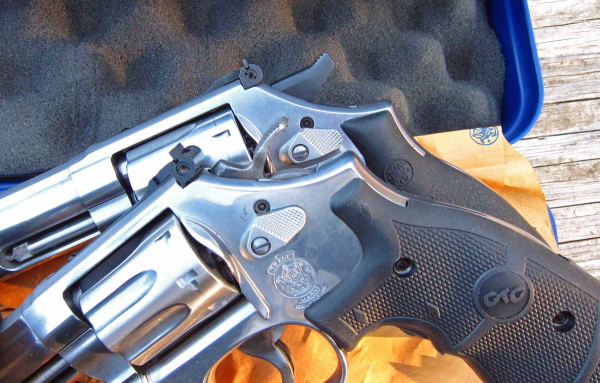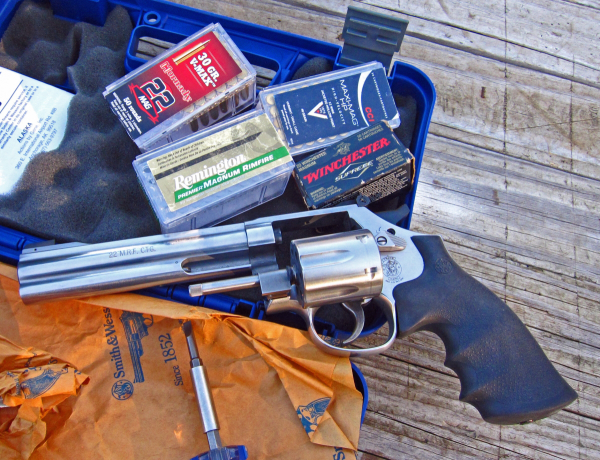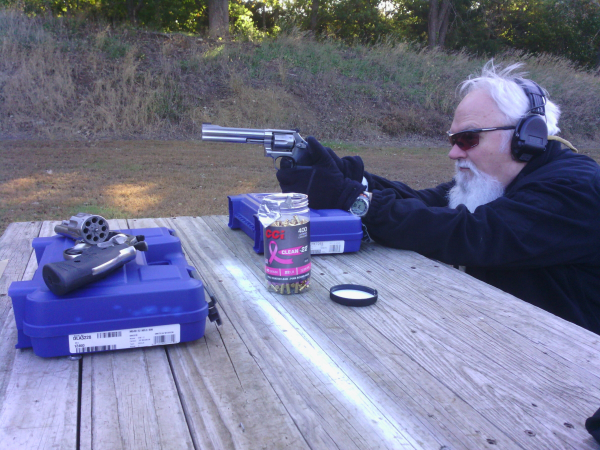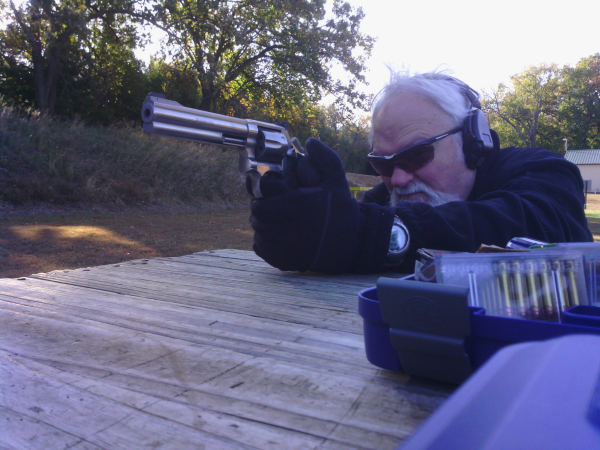This edition of "Wheelgun Wednesday" appeared in our service in October 2019.

It’s been a few months since I saw the social media post regarding a new product from Apex Tactical. It promised a near-6 pound double action pull featuring 100% reliability with CCI Mini-Mag, Winchester Super-X and Remington Golden Bullet. It was supposed to be a ‘drop-in kit.’
Really? That was a coincidence. Some years back, I found complete M648 22 mag cylinders on Gunparts.com. I contacted S&W and asked about them fitting one to a standard Model 617. Tony Miele checked with the Performance Center, then set it up. I got the cylinder, sent it in – and now it’s a convertible 617, marked "22 M.R.F." on the barrel with a 22 mag cylinder and the original 22 LR cylinder. Both cylinders are marked in the back with “MAG” or “LR” to help me keep things straight.
The trigger was okay for me as the gun sat, but I asked Randy Lee about the new Apex kit and whether it would work with 22 Magnum as well. The response was “send us the gun.”
I did. Meanwhile innovation in design and production continued. So now it’s back. The hammer, black in color, extends just a bit more than the S&W target hammer on the new S&W Model 648 – which I still had for T&E. It’s unaltered – an 8-shot instead of a six shot – and it shoots very well indeed.

As to the new hammer, here are the details.
“The new Mass Driver hammer is substantially heavier than our previous version. Here is the weight breakdown for the factory hammer, our original Mass Driver and the new version:
So the new MD hammer is 5.43 grams heavier than the factory original – what, around .2 of an ounce? Doesn’t seem like much, but consider that the original weighed less.
Together with the Performance Center-fitted 22 Magnum cylinder, I took a selection of ammo out to the range. I’d wondered if the new hammer would light Magnum rimfire off . . . it will sometimes. Not being made to serve that purpose, it was an interesting exercise, but I had no trouble with a partial box of Remington Premium Magnum nor with a bit of Maxi-Mag (35 degree wind chill, called the test short), but with Hornady V-Max and Winchester 30 gr. HP Mags, in either SA or DA, they were having failures to fire.
With 22 LR, it's 100% -- and nothing is 100% with the bulk pack stuff I often use; this time it was the Remington bulk Golden Bullet and CCI "Clean-22 Pink."

I first tried it with CCI’s new “Clean-22 Pink” 22 LR loads. A 40 grain bullet, the gun fired them without incident – as expected. The DA pull was light and even. Single action was short, light and broke sharply. I had some vintage Remington Premier Magnum Rimfire loads. After swapping cylinders to the Magnum Rimfire, I tried that partial box. It put forth considerable flame with a sharp report, but fired both DA and SA. It was looking like the light action would be fine with magnum rounds.
From a seated rest at about 20 yards from the target I tried three loads: the Hornady 30 gr. V-MAX, CCI Maxi-Mag 40 gr. JHP and Winchester Supreme 30 gr. JHP. Shooting all loads single action I found that five-shot groups were yielding around 2-inch groups. The best three of five, allowing us to rule out shooter error, averaged an inch. The problem was light strikes. Round #3 of the Hornady failed to fire, lighting on the second go-around. It was Round #4 of the Winchester Supreme that failed to fire.
Working through the rest of the ammo in double action, I had failures to fire with Hornady. Swapping cylinders, I quickly put a mixed hundred rounds of Remington Golden Bullet 22 LR bulk packed and more CCI Clean-22 “Pink.” The gun rattled through the ammo with no issues.
I checked in with Randy Lee at Apex. His reply to my question about MRF ammo not lighting follows:
“Most likely the WMR brass requires more deformation due to the rim thickness differences. My guess is that the strain screw would need to be turned in so that the hammer fall weight as measured with a Lyman trigger pull gauge would measure 3 -3.25 lbs. (this would result in a TPW of about 7 lbs). The setting as I sent it out was at 2 lbs 12 oz which set off CCI MiniMags, Federal Bulk and Winchester Bulk .22 lr. The trigger pull weight was around 6.25 lbs if I recall.”
Having tightened down the strain screw, I made another range trip. With the single action set to just over 3.5 pounds, I fired the remainder of the Hornady V-MAX loads and CCI Maxi-Mags as well. Zero issues with ignition.
Not satisfied, I swapped out cylinders and ran around fifty rounds of CCI “Clean-22” through the gun. I settled for fifty yard steel targets. Once I knew where to hold – with either caliber – the Model 617 just couldn’t seem to miss. The trigger is only slightly heavier – shooting in both single- and double-action.
Why the change from the original Apex M617 hammers?

“With the release of the first generation Mass Driver hammers, I was successful in getting 617s to run reliably in the 6-6.5 lb range. However it took a lot of finesse to get them there. As a result, sales were limited to those competitors and ‘smiths who knew their way around a Smith action.
“And now, it’s user upgradeable.
“So I decided to make a kit that followed the successful formula that we used to make our M&P action kits a household brand – a drop in kit. With the added mass in the right locations and a single action notch, we made a kit that anyone with minimal knowledge could throw into a stock 617 and enjoy a reliable 6-7 lb DA/ 3 lb SA . Similar results happened when we installed the kit into a 357 L – frame.
“Hopefully the new kit will gain wider acceptance across the board for sport shooters, hunters and even those who use the firearm for self-defense but have limited hand strength.”
What does the future hold?
“We will be offering a mass driver for the N – frame as well. Most of the competition guns set up to fire handloads with well seated Federal primers fall in the 6-7 lb. (range). Now competitors can run the same trigger pull weight but not be limited to Federal primers.”
He also trued up the cylinder and crane as there was drag on the cylinder – something I couldn’t detect with the factory fire control parts. The rebound spring was likewise replaced. The kit, perhaps available in the first quarter of the New Year, will likely replace the Mass Driver TDA hammer assembly, two reduced power rebound slide springs and a reduced power firing pin spring. The same kit should be available for centerfire L-frame S&W revolvers.
But the only slightly heavier hammer makes the difference?
“The energy of the system is conserved when the hammer hits the firing pin between all three hammers. The thing I found was that the heavier hammer transmits the impact force for a longer period of time before rebound forces of the primer hitting the firing pin back (as it were) can degrade the striking force being applied by the hammer. In a nutshell, it means that there is more time for the rim to get deformed and ignite.”
He also noted that experienced revolver shooters will perceive how slowly the hammer moves. It looks like Randy Lee and Apex Tactical have done it again.
Stay tuned.
-- Rich Grassi